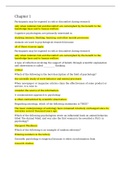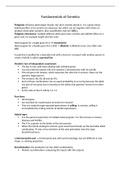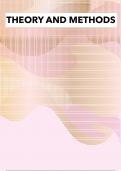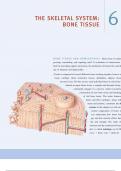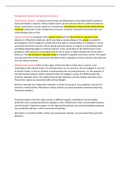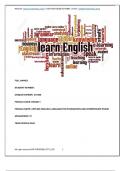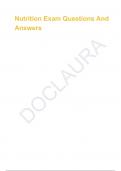Disease and Body Defence
The role of microorganisms in causing infectious diseases
Microorganisms are identified as small microscopic organisms, by using the term
microscopic it is implying that the organisms cannot be visible to the naked eye.
Microorganisms include bacteria, viruses, fungi or parasites. Microorganisms can be found
all over in our bodies, in food what we consume, in plants, water etc. Most microorganisms
are known to be non-harmful to us humans and some even as protect us by preventing the
growth of pathogens. Pathogens are known as microorganisms that can cause infectious
diseases and are quite harmful to us humans. In order to cause infectious disease, the
pathogens will primarily need to be transmitted to an individual and then overcome the
human body’s defence system. (Janeway CA jr et. al. 2001)
Pathogens can cause illnesses to an individual in various ways. The primary and quite
obvious mean is through direct damage to the cells in replication or tissues. This is usually
done through the production of toxins, which are known to allow the pathogens to reach new
tissues or to exit the cells that are inside which it replicated. Examples of agents that can
cause diseases are bacteria, viruses, fungi, parasites, protozoa. Parasites and Protozoa are
typically categorized into the same group as they are both classified as subjects of the
discipline of parasitology. Bacteria, viruses and fungi are however classified as subjects of
microbiology. (Janeway CA jr et. al. 2001)
How infectious diseases can be transmitted and discuss specific examples
The process of an infection is usually divided into different stages, each of which can be
blocked by the various defence mechanisms. The first stage is when a host is first exposed to
the infectious particles of a disease that was emitted by an already infected person. The first
route of transmission and stability/strength of the infectious agent outside the host typically
has a big role in determining the infectivity of the infectious disease. The first contact with a
new host that is yet not infected occurs through an epithelial surface, epithelial surfaces aims
to the skin, the mucous membranes of the respiratory system (including the mouth, nose,
eyelids, trachea, lungs etc.), the gastrointestinal (includes the mouth, oesophagus, stomach,
the small intestine, the large intestine, and anus) and the urogenital tract (includes the
organs of the reproductive and the urinary system). Once the contact has been established,
an infectious agent will have to set a focus of infection, such as adhering to the epithelial
surface and overcoming it or penetrating it in order to replicate itself in the tissues. This is
the stage in which many of the microorganisms are opposed by the body’s innate immunity.
The innate immune system responses operate by using various germline-encoded receptors
that will distinguish between the infected and regular cells. However, the innate immune
responses are known to be less effective in comparison to the adaptive immune responses.
(Janeway CA jr et. al. 2001)
As previously mentioned, some pathogens will multiply between the cells of the host or
within body fluids, while other pathogens such as viruses and some bacterial species usually
The role of microorganisms in causing infectious diseases
Microorganisms are identified as small microscopic organisms, by using the term
microscopic it is implying that the organisms cannot be visible to the naked eye.
Microorganisms include bacteria, viruses, fungi or parasites. Microorganisms can be found
all over in our bodies, in food what we consume, in plants, water etc. Most microorganisms
are known to be non-harmful to us humans and some even as protect us by preventing the
growth of pathogens. Pathogens are known as microorganisms that can cause infectious
diseases and are quite harmful to us humans. In order to cause infectious disease, the
pathogens will primarily need to be transmitted to an individual and then overcome the
human body’s defence system. (Janeway CA jr et. al. 2001)
Pathogens can cause illnesses to an individual in various ways. The primary and quite
obvious mean is through direct damage to the cells in replication or tissues. This is usually
done through the production of toxins, which are known to allow the pathogens to reach new
tissues or to exit the cells that are inside which it replicated. Examples of agents that can
cause diseases are bacteria, viruses, fungi, parasites, protozoa. Parasites and Protozoa are
typically categorized into the same group as they are both classified as subjects of the
discipline of parasitology. Bacteria, viruses and fungi are however classified as subjects of
microbiology. (Janeway CA jr et. al. 2001)
How infectious diseases can be transmitted and discuss specific examples
The process of an infection is usually divided into different stages, each of which can be
blocked by the various defence mechanisms. The first stage is when a host is first exposed to
the infectious particles of a disease that was emitted by an already infected person. The first
route of transmission and stability/strength of the infectious agent outside the host typically
has a big role in determining the infectivity of the infectious disease. The first contact with a
new host that is yet not infected occurs through an epithelial surface, epithelial surfaces aims
to the skin, the mucous membranes of the respiratory system (including the mouth, nose,
eyelids, trachea, lungs etc.), the gastrointestinal (includes the mouth, oesophagus, stomach,
the small intestine, the large intestine, and anus) and the urogenital tract (includes the
organs of the reproductive and the urinary system). Once the contact has been established,
an infectious agent will have to set a focus of infection, such as adhering to the epithelial
surface and overcoming it or penetrating it in order to replicate itself in the tissues. This is
the stage in which many of the microorganisms are opposed by the body’s innate immunity.
The innate immune system responses operate by using various germline-encoded receptors
that will distinguish between the infected and regular cells. However, the innate immune
responses are known to be less effective in comparison to the adaptive immune responses.
(Janeway CA jr et. al. 2001)
As previously mentioned, some pathogens will multiply between the cells of the host or
within body fluids, while other pathogens such as viruses and some bacterial species usually


